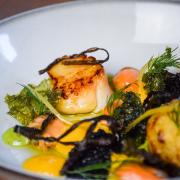Rhubarb once had a life as a vegetable, but in 1947 it is was officially recognised as a fruit. But still it wasn't what you'd called sweet.
So it had to be 'forced' to be sweet', resulting in rosy, tender, sweeter stems expertly honed by families of Yorkshire growers.
In its heyday, 1900’s-1940’s a massive 30-square-mile rhubarb growing hub developed between Wakefield , Leeds and Bradford, a gargantuan rhubarb ‘patch’ affectionately known as ‘The Yorkshire Triangle’. This and the wider farming hinterland, comprised of claggy soils, cold, wet winters with the added advantage of the Pennine frost pocket, served out-door growing of rhubarb perfectly well. In tandem with local sheep farming, the wool industry provided nitrogen rich waste, ‘shoddy’, the final requisite ingredient for successful growing.
Following the inadvertent discovery of ‘forced’ rhubarb, uncovered at the Chelsea Physic Garden in 1817, which renders earlier, sweeter-tasting and tender stems, legendary rhubarb forcing sheds sprung up in proximity to Yorkshire's railways, some actually in disused railway sheds.
Warmed by a then cheap and plentiful supply of coal, Yorkshire’s rose-gold was grown undercover, secreted in darkness, plucked by candlelight (to preserve the desired red-pink stem colour and minimise leaf growth) hundreds of thousands of stems raced from Yorkshire on a daily ‘Rhubarb Express’ to feed the greed of London’s Spitalfields and Covent Garden Markets.

Yorkshire grew the lion’s share of Britain’s rhubarb, developing earlier, later, sweeter, longer, more vigorous, redder, pinker, softer varieties to maintain advantage and momentum.
Disastrously for the industry, the war years brought rationing, sugar became scarce rendering the largely suck-sour fruit pretty unpalatable. A few entrepreneurial farmers grew sweet cicely, a natural sweetener, alongside the rhubarb, it’s slightly aniseed taste tempering or at best neutralising the sharpness. Without the luxury of sugar, rhubarb slipped from popularity as a new wave of exotic, imported fruits hit our shores.
Whilst forced rhubarbs volumes today are massively reduced and many sheds, like fifth generation E. Oldroyd and Son Ltd. and Tomlinson's double as historic tourist attractions, a sweet-tasting, reduced nine-square-mile-slice of the pie remains. In 2010, rhubarb forced inside the Yorkshire Triangle, regardless of the variety, was awarded, prestigious P.D.O. status, joining the esteemed likes of Champagne and Parma Ham, recognising that the taste cannot be replicated beyond the confines of the county.

Heritage heroes
In celebration of Yorkshire's rhubarb prowess, RHS Yorkshire Garden Harlow Carr has created a large, triangular rhubarb bed, which spills with more than 60 locally-grown including 12 Yorkshire-bred varieties, adjacent to the Kitchen Garden. The core of the collection dates back to 1985 and originates largely from Stockbridge, with additions from private collectors and generous gardeners. Plants are grown out in the open, some forced under traditional terracotta rhubarb forcers. This outdoor, living rhubarb library is laced with nostalgic plantings of sweet cicely.


Which varieties to grow.
This depends on taste, timing and space available. Choose earlier varieties for forcing and later ones to prolong availability.
Timperely Early; AGM. Lancashire. A superb, well-known, early forcing variety, good colour and flavour, cropping from January indoors, outdoors harvest from Earl-Mid April.
Reeds Early Red, early forcing variety, deep colour, earthy flavour. Retains good colour outdoors.
Stockbridge Arrow; Yorkshire. the one to beat, main-crop, early-mid May. Outstanding modern, must-have variety, excellent flavour, colour, high yields, for forcing or the garden.
Cawood Delight, Yorkshire. bred at Stockbridge; a modern deep red fruit, high fibre levels help retains colour and form when cooking. Not for forcing or for beginners.
Raspberry Red; Yorkshire. early season, modern variety, deep red stems and sweet flavour without the need for forcing.
Paragon, Yorkshire. one of the very earliest varieties, dating back to1878, heavy lovely red stalks and good flavour
Victoria London; a famous, standout heirloom variety with large fat stems and deep red colouring, late-cropping mid-late May, full of vigour and tart flavour without the stringiness. Good for garden and forcing, popular with bottlers and jam-makers.


RHS guide to garden-growing rhubarb.
Buy dormant, bare root plants (crowns) mid-autumn- early spring, or potted plants year round (avoid planting pots in hot, dry weather).
Plant in an open sunny site, in fertile, moist but well-drained soil.
Add well-rotted manure to planting site, 2 buckets of manure per m2.
Leave plenty of space between plants, 70-90cm, dig a hole slightly larger than the roots, position so the tip of the crown, where the leaves emerge, is just above the soil. Back fill and firm in before watering well. (Continue to water young or containerised plants)
Do not harvest in its first season, pluck sparingly year two to render good crops year three onwards.
Force rhubarb for earlier, sweeter stalks, covering early season varieties with a terracotta rhubarb forcer or similar.
Pluck, dislocating each stem from the very base of the plant, do not cut.
Harlow Carr’s rhubarb collection can be enjoyed throughout the rhubarb season from late spring to early summer
rhs.org.uk/gardens/harlow-carr,
Oldroyd and Sons Ltd. Farm tours to the forcing sheds will resume in January 2025 due to relocation of forcing operations from Carlton to Loft house farm. eoldroyd.co.uk

Rhubarb crumble recipe
Irresistibly sweet and tart in one delicious mouthful, there’s nothing quite like a homemade Yorkshire rhubarb crumble, heavenly with a dollop of creamy, yellow custard. Best served hot but love those chilled leftovers- if there are any.
Ingredients; serves 4-6.
The filling
½ kg Yorkshire rhubarb stems, cut into 2cm lengths
50gms caster sugar (increase to taste if rhubarb is particularly tart)
50 ml of orange or apple juice
The crumble
150g plain flour
100 g unsalted butter
50g caster sugar
A pinch of salt
1 tablespoon light muscovado sugar for topping.
Instructions;
1. Pre heat oven to 200 degrees C.
2. Tip all the filling contents into a heavy based, simmer gently, stirring occasionally until the rhubarb is tender, but holding shape 7-10 minutes, forced rhubarb is more delicate and requires less cooking. Don’t overcook as the fruit as it will lose its bite and take on a slimy texture. Adjust fruit sweetness to taste, bearing in mind the sweet and crunchy taste of the crumble itself. Set aside to cool.
3. In a large mixing bowl rub together, yes with your fingers, the butter and the flour until the mixture looks like fine breadcrumbs. Mix in the caster sugar.
4. Half-fill individual heart-shaped, oven proof serving dishes ( Le Creuset red stoneware ramekin)or one large dish, with the cooled rhubarb mixture and top with a generous layer of crumble. Sprinkle with muscovado sugar for extra chewy crunch.
5. Pop in the hot oven until bubbling and golden-approximately 15 minutes for ramekins, 20 minutes for larger dish. Allow to cool slightly before serving with custard, cream or crème fraiche.

Quick Rhubarb and custard tea time tartlets recipe
The perfect combination, slightly tart stewed rhubarb with a dollop of creamy custard served up in bite size tea pastry cases. This is a quick and easy short-cut recipe if you are short of time; you can buy readymade pastry cases, use leftover trimmings from a large pie or make pastry as above, from scratch, halving the quantities for these topless tarts. Likewise custard you can use ready-made custard, make your own using custard powder or make from scratch if preferred.
Short-cut ingredients;
1 packet of mini sweet pastry tartlets.
1 tin or carton of readymade custard (warm or chilled)
250g rhubarb, cut into 2cm batons
30 g sugar
Instructions
1. Pop the cut rhubarb and sugar into a heavy based pan, bring to a low simmer, stirring occasionally until the rhubarb is tender, but holding shape 7-10 minutes, forced rhubarb is more delicate and requires less cooking. Don’t overcook as the fruit as it will lose its bite and take on a slimy texture. Adjust fruit sweetness to taste, forced rhubarb generally is sweeter and more colourful then often sharper, greener garden grown fruit. Allow to cool. Alternatively you can use
2. Assemble the tartlet, adding a dollop of warm or chilled custard, top with a spoon full of cooked (warm or chilled) rhubarb, draining away excess liquid which will make the pastry case soggy. Alternatively simply top with a single, firm but cooked baton of rhubarb and serve warm or chilled.
3. Alternatively, if you can use excess rhubarb batons from the Rhubarb in orange and ginger syrup recipe.( below)

Rhubarb in Orange and Ginger Syrup recipe
According to Chef Marcus Wareing, (I’m afraid Wareing, the son of a fruit and potato merchant, is originally from Lancashire not Yorkshire!) the following ingredients make perfect partners; ‘the slight heat from the ginger complements the sharp rhubarb- and orange brings sweetness to the dish.’
Ingredients; Serves 4-6
½ kilo tender young or forced rhubarb cut into 10cm batons
Juice and orange zest (optional)
75 g caster sugar
1 tbsp. stem ginger syrup
Vanilla ice cream to serve.
Instructions;
1. Preheat oven to 130 degrees C.
2. Put the rhubarb in a casserole dish and coat with the combined mixture of all the other ingredients. Spread rhubarb evenly over the base of the oven proof dish and cover with foil.
3. Bake for 20-25 minutes until the fruit is soft but still holding its shape, time will vary according to tenderness and thickness of rhubarb.
4. Remove from oven, remove foil and allow to cool a little.
5. Serve warm with a scoop of vanilla ice cream.
Nb. The syrup can be sieved (to remove ginger, zest and other bits) and added to flavour old fashioned,
pink lemonade, (add a twist of lemon and sprig of mint or sweet cicely if you have any) prosecco or champagne.

Rhubarb Orange and Ginger Cake recipe
A lovely moist and tangy cake, eat warm as a desert, cold for afternoon tea.
Ingredients
440g rhubarb, cut to 3 cm lengths
280g golden caster sugar
225 g butter, diced and at room temperature.
1 orange, zest and juice.250 g self-raising flour
1 knob of ginger- finely grated
1 tsp baking powder
3 medium eggs
Instructions
1. Pre heat the oven to 180 degrees C.
2. Pop the cut rhubarb in a bowl, sprinkle with 50g of the sugar and leave for half an hour. Line a 20cm square or round cake tin with baking paper or grease and flour a loose-based tin so as to ease out the baked cake.
3. In a separate mixing bowl, add the rest of the sugar, diced butter, orange zest, juice and grated ginger and whisk to a smooth paste before sieving in the flour and baking powder and adding the eggs. Beat until smooth.
4. Just before you tip the mixture into the tin, fold in the rhubarb and add some of the juices, retaining the consistency of cake mixture without being runny. Bake for an hour until well risen and golden, (you can cover with foil to avoid the burnt look!) using a skewer, test if the middle is baked through. Return to the oven for up to 15 minutes as required.
5. Allow to cool/set before removing from the tin. Serve warm, or cool on a wire rack to avoid a soggy bottom.

Bottling Rhubarb; preserving.
Bottling is a great way to preserve any rhubarb, so you don’t waste a single stem and can enjoy the fruits of your labour throughout the entire year. The firmer, redder varieties look best.
Ingredients
3 kilos of trimmed rhubarb, cut into 2-3 cm chunks.
½ kilo granulated sugar
1 litre water
6 x 300 ml Kilner or jars with fitted lid, sterilised (can be done easily in the dishwasher).
Jam pan
Jam thermometer
Instructions
1. In heavy-based (jam) pan bring the water to the boil, pour and stir through the sugar, simmering until dissolved.
2. Place the chopped rhubarb into a large basin, cover with the preserving sugar syrup, leave to steep overnight.
3. With a slotted spoon, jam pack the sterile jars with rhubarb fruit( omitting as much liquid as possible at this stage)
4. Bring the rhubarb syrup back to the boil and top up the jar, almost to the rim before securing the lids.
5. Put all the jars in a bottler or large jam pan, ensuring they don’t touch (separate them with a rolled up or tea towel liner) fill the pan with water to just cover the lids, and loosen slightly to relieve pressure (but not enough to let water in) before bringing the pot slowly to a slow simmer at 90 degrees C for 5 minutes.
6. Using protective gloves or a cloth, lift each jar out of the pan and screw tight the seal making the dome pop, creating a tight seal for the rhubarb. Once cool, preserved rhubarb can be kept for around 12 months, retaining colour better if kept in a dark cupboard.

Rhubarb Clafoutis recipe
Serves 4-6
A creamy, batter-based, oven-baked variation of rhubarb and custard.
Ingredients;
Filling
20g butter
400g rhubarb (forced is preferable) cut into 5cm batons.
2 tbsp granulated sugar
Batter mix
150ml milk
150ml double cream
Drop of vanilla essence
5 medium-sized eggs
120 caster sugar
75g plain flour
Oil and sugar for lining 20cm oven proof pan or dish.
Instructions
1. Pre heat oven to 180 degrees C.
2. Make the filling by melting the butter in a heavy based pan, before adding the rhubarb and sugar. Sizzle and soften for just a couple of minutes and then leave to cool.
3. In a separate pan, pour in the milk, cream and a drop of vanilla essence, warm up gently to a simmer, remove from the heat to cool.
4. In a large mixing bowl whisk together the eggs before adding and whisking in the caster sugar. Gently fold in the flour, making sure there are no lumps, before adding the cooled vanilla cream/milk mix to complete the batter.
5. Grease a 20cm ovenproof pan or dish with a dash of oil or melted butter together with an additional small sprinkling of sugar before arranging the firm rhubarb.
6. Pour the batter mixture over the rhubarb and pop into the oven to bake 40-45 minutes. The clefoutis should be ‘set’ and golden.
7. Scoop servings directly from the oven pan/dish, serve warm with cream, ice cream or crème fraiche.

Rhubarb – join the fun
Wakefield’s celebration of its most famous vegetable, the Rhubarb Festival, returns to paint the city pink for three days from 16-18 February 16-18.
With the all-important food and drink market returning this year, there will be over 50 chalets where visitors can look forward to sampling and purchasing a wide range of local and regional rhubarb-flavoured delights.
Families will love the array of workshops on offer, as well as a whole host of children’s activities and lively street entertainment. You can also expect a whole new programme of chef demos to expand your culinary skills.
Have an evening of laughs at the Rhu-bar Comedy Night on the Friday and Saturday evening. Get ready to be tickled pink with comedians Angelos Epithemiou or Britain’s Got Talent’s Lost Voice Guy.
Finally, extend your stay with the Rhubarb Food & Drink Trail around the city, showcasing restaurants and bars putting on rhubarb themed food and drink throughout the weekend
expwake.co/RhubarbFest
Rhubarb – how we do ours
Jane McDonald, whose hometown is rhubarb capital, Wakefield
‘A chunk dipped in a big bag of sugar – and of course a rhubarb crumble’
James Martin
‘Rhubarb crumble cake with ginger cream; ‘the most of gorgeous seasonal ingredients. How can you resist two desserts combined into one?’ See the recipe at jamesmartinchef.co.uk
James Mackenzie, Pie & Glass, Dalton
Forced Yorkshire rhubarb trifle with rum soaked parkin crumbs – the ultimate Yorkshire treat. Recipe at greatbritishchefs.com
Tommy Banks
Rhubarb & custard pots with rosemary crumble - delightful individual puds that make for the perfect after-dinner treat. Recipe at waitrose.com



























